The Duty to Resist
Atila Sinke Guimarãess
Unhappily the Holy Catholic Church is passing through
difficult days today. About one century and a half ago she was enjoying
one of her more glorious periods. After the proclamation of the dogma of
Papal Infallibility (1870), the influence of the Papacy reached a new
high point in History. Even though Papal Infallibility applied
exclusively to some extraordinary pontifical teachings, it
understandably radiated into other fields of papal activity.
The common teachings of the Pope were regarded with much more respect.
His acts of government took on characteristics of perennial laws. His
liturgical, exegetic and canonical decisions came to be considered as
almost perfect and holy. The proclamation of Papal Infallibility shed a
kind of golden aura on the Papacy thereafter.
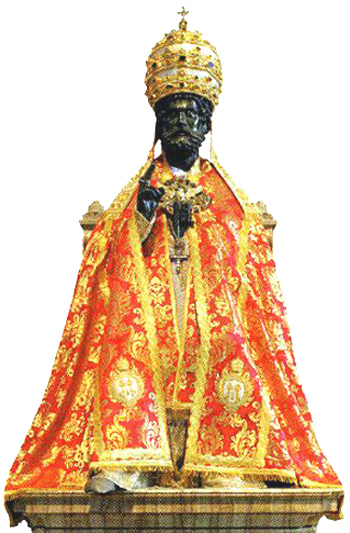
The golden aura of papal infallibility radiated on all the ecclesiastic offices
This caused joy among Catholics, especially those turned toward the
counter-revolutionary fight, that is to say, those who understand that
there is a centuries-old conspiracy, a Revolution, to destroy the Church
and Christendom, and who thus dedicate their lives to defend them from
this Revolution.
In a secondary refraction, the light of Papal Infallibility cascaded
over the whole Church Hierarchy. With different intensities Cardinals,
Archbishops, Bishops and priests came under the same aura that radiated
from the Supreme Pontiff. Thus, at the end of the 19th century and
beginning of the 20th century, the Spouse of Christ saw the concept of a
Monarchical Church splendidly established.
The natural consequence of this process was obedience. All hierarchical
institutions proceed from obedience and generate obedience. This also
happened in the Catholic Church.
These three characteristics – the exaltation of the Papacy, an increased
respect for the Hierarchy and the obedience of the faithful –
represented a victory for the Counter-Revolution:
- A victory against the Protestant Revolution that denied the Papacy;
- A victory against the French Revolution that launched itself against the Monarchy in the State and in the Church;
- A victory against the liberal Catholic movement of the first half
of the 19th century that wanted a tolerant and democratic Church adapted
to the modern world.
These victories thus enthused what there was of the best and most
healthful among Catholics. Because of this enthusiasm, these elements
remained a lively presence up to the vespers of Vatican II.
When obedience serves the self-destruction of the Church
By a curious irony of History, after the de facto installation of
Progressivism in the directive bodies of the Church with Vatican
Council II, these same characteristics came to play a role that, in
practice, worked in an opposite direction. They came to serve the
self-destruction of the Church.
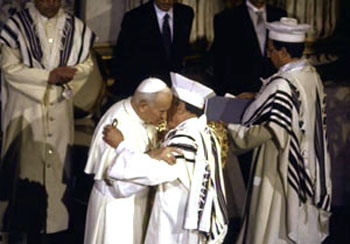
Contradicting past teaching, John Paul II enters the Rome Synagogue and embraces the chief rabbi
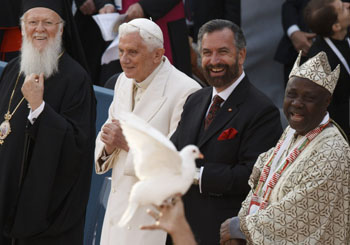
Benedict follows JP II's example, meeting with false religions, even voodoo witch doctors at Assisi
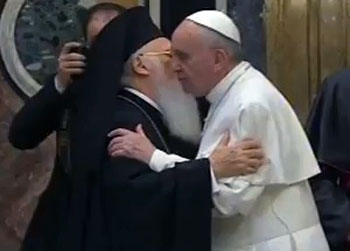
Francis embracing a schismatic patriarch at his first meeting with leaders of world religions March 20, 2013
John XXIII, Paul VI, John Paul II, Benedict XVI used this acquired
prestige to spread principles different from the perennial teaching of
the Magisterium. Mater et Magistra, Pacem in terris, Ecclesiam suam,
Populorum progressio, Sollicitudo rei socialis, Mulieris dignitatem, Ut
unum sint, Tertio millennio adveniente nte and Caritas in veritate are some pontifical documents in which one notes this new teaching.
The express thinking in the principal documents of Vatican II clashes
with earlier ordinary and extraordinary pontifical teachings as well.
Written in a deliberately ambiguous language, such documents are founded
on the same Nouvelle Théologie [New Theology] previously condemned as heterodox, especially Lumen gentium, Gaudium et spes, Unitatis redintegratio, Dignitatis humanae and Nostrae aetate.
Thus, by a kind of “wave of the magic wand,” the Church radically
changed her appearance. What was wrong came to be right, what was
certain came to be uncertain. Today there is talk of abolishing Quanta cura and the Syllabus of Pius IX; the Encyclical Pascendi is called outdated; so also the Decree Lamentabili and the Anti-Modernist Oath.
The dogmatic constitutions of the Council of Trent and the anathemas
against Liberalism are set aside. Pardon is asked for the age-old
dogmatic teaching against the errors of the Jewish religion.
What was the secret force that led almost the whole body of Catholics to
the relative acceptance of this enormous change, certainly the greatest
ever witnessed in History? It was due primarily to the action of the
three aforementioned factors: papal prestige, the strength of the Church
Hierarchy and the obedience of the faithful.
The difficult situation of faithful Catholics
Paradoxically, for more than a century, counter-revolutionary Catholics
were the principal artisans who established these three factors on an
institutional level. However, after John XXIII was raised to the
Pontifical Throne, they were the ones who suffered most from the
application of these elements. The choir of progressivists,
permissivists, the pusillanimous and the mediocre even today launch
against these Catholics the epithets of being “against the Pope,”
“disobedient to the Hierarchy,” “outside the Church.”
Thus, they see themselves in the sad circumstance of defending the
Papacy but resisting the progressivist teachings of the conciliar Popes.
They continue to love with ever increasing ardor the monarchic
characteristic of the Church, to venerate the chains of dependency that
link the lesser with the higher. At the same time, they do not hesitate
to deny their obedience to the Hierarchs who are promoting the
auto-demolition of the Church.
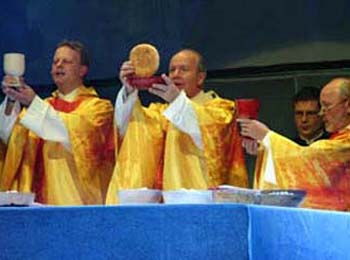
Faithful Catholics are perplexed at Masses like the one concelebrated by Card. Schonborn of Vienna, above
The situation of these Catholics is delicate and paradoxical. Faced with
the dilemma: “Fidelity to principles or to persons? Orthodoxy or
obedience?” they adhere to the principles and resist the unorthodox
authority.
From this the question necessarily arises: By acting in this way, do they place themselves outside the Church?
The answer is no, positively no. They constitute one of the most
precious parts of the faithful. They are following the divine example of
Our Lord, who, obedient to the Synagogue authorities in everything that
was possible, nonetheless did not fear to disagree with them in
discussions and deny them obedience in all that opposed true doctrine.
This attitude does not imply either placing oneself outside the Church
or of standing in judgment of the Pope.
Such a conclusion, however, is not only mine. Many great Saints and
Doctors of the Church have spoken on this matter and recommended this
attitude. The doctrine on the right of the faithful - even the most
simple - to resist decisions of ecclesiastical authorities that are
dangerous to the Faith and objectively erroneous, was expounded by
Saints and Doctors of the Church, as well as by famous theologians.
St. Thomas on resisting errors of Prelates
St. Thomas Aquinas, in many passages of his works, upholds the principle
that the faithful can question and admonish Prelates. For example:
“There being an imminent danger for the Faith, Prelates must be
questioned, even publicly, by their subjects. Thus, St. Paul, who was a
subject of St. Peter, questioned him publicly on account of an imminent
danger of scandal in a matter of Faith. And, as the Glosa of St.
Augustine puts it (Ad Galatas 2,14), ‘St. Peter himself gave the
example to those who govern so that if sometime they stray from the
right way, they will not reject a correction as unworthy even if it
comes from their subjects.’” (1)
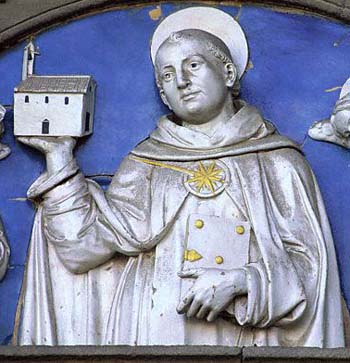
St. Thomas affirms that the faithful have the duty to resist teachings that contradict the past Magisterium
Referring to the same episode, in which St. Paul resisted St. Peter “to
his face,” St. Thomas teaches: “The reprehension was just and useful,
and the reason for it was not trivial: there was a danger for the
preservation of evangelical truth ... The way it took place was
appropriate, since it was public and open. For this reason, St. Paul
writes: ‘I spoke to Cephas,’ that is, Peter, ‘before everyone,’ since
the simulation practiced by St. Peter was fraught with danger to
everyone.” (2)
The Angelic Doctor also shows how this passage of the Scriptures
contains teachings not only for Hierarchs, but for the faithful as well:
“To the Prelates an example of humility was given so that they do not
refuse to accept corrections from their inferiors and subjects; and to
the subjects, an example of zeal and liberty so they will not fear to
correct their Prelates, above all when the crime is public and entails a
danger for many.” (3)
In his Comments on the Sentences of Peter Lombard, St. Thomas
teaches how respectfully correcting a Prelate who sins is a work of
mercy all the greater as the Prelate’s position is higher: “Eccl. 17:12
says that God ‘imposed on each one duties toward his neighbor.’ Now, a
Prelate is our neighbor. Therefore, we must correct him when he sins.
...
“Some say that fraternal correction does not extend to the Prelates
either because a man should not raise his voice against heaven, or
because the Prelates are easily scandalized if corrected by their
subjects. However, this does not happen, since when they sin, the
Prelates do not represent heaven and, therefore, must be corrected. And
those who correct them charitably do not raise their voices against
them, but in their favor, since the admonishment is for their own sake.
... For this reason …. the precept of fraternal correction extends also
to the Prelates, so that they may be corrected by their subjects.”(4)
Other theologians and Saints on resisting a Pope
Fr. Francisco de Vitoria, O.P., poses these questions: “A Pope must be
resisted who publicly destroys the Church. What should be done when the
Pope, because of his bad customs, destroys the Church? What should be
done if the Pope wanted without reason to abrogate Positive Law?”
His answer is: “He would certainly sin; he should neither be permitted
to act in such fashion nor should he be obeyed in what was evil; but he
should be resisted with a courteous reprehension. Consequently ... if he
wanted to destroy the Church or the like, he should not be permitted to
act in that fashion, but one would be obliged to resist him.
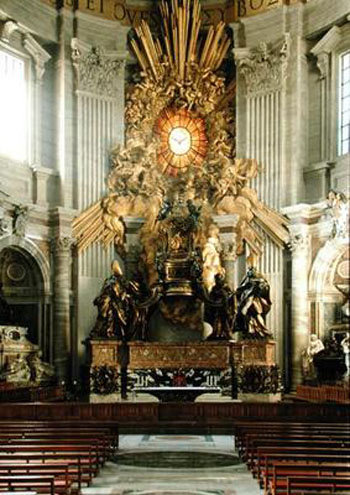
The Chair of Peter must be guarded from errors - even those made by Popes
“The reason for this is that he does not have the power to destroy.
Therefore, if there is evidence that he is doing so, it is licit to
resist him. The result is that if the Pope destroys the Church by his
orders and actions, he can be resisted and the execution of his mandates
prevented.” (5)
Fr. Francisco Suarez, S.J., also defends this position: “If [the Pope]
gives an order contrary to good customs, he should not be obeyed. If he
attempts to do something manifestly opposed to justice and the common
good, it would be licit to resist him. If he attacks by force, he could
be repelled by force, with the moderation appropriate to a just
defense.” (6)
St. Robert Bellarmine, the great paladin of the Counter-Reformation,
maintains: “Just as it is licit to resist a Pontiff that aggresses the
body, it is also licit to resist one who aggresses the soul or who
disturbs civil order or, above all, one who attempts to destroy the
Church.
“I say that it is licit to resist him by not doing what he orders and
preventing his will from being executed. It is not licit, however, to
judge, punish or depose him, since these are actions proper to a
superior.” (7)
Fr. Cornelius a Lapide, S.J., argues: “Superiors can, with humble
charity, be admonished by their inferiors in the defense of truth; that
is what St. Augustine, St. Cyprian, St. Gregory, St. Thomas and others
declare about this passage (Gal. 2:11).
“St. Augustine wrote: ‘By teaching that superiors should not refuse to
be corrected by inferiors, St. Peter gave posterity an example more rare
and holier than that of St. Paul as he taught that, in the defense of
truth and with charity, inferiors may have the audacity to resist
superiors without fear’ (Epistula 19 ad Hieronymum).” (8)
The duty to resist
Applying these teachings to our days, the conclusion is very grave and
very simple: Catholics who truly love the Church have the duty to resist
the doctrines, laws, norms and orders coming from an ecclesiastical
authority, especially if it be the Pope, which favor Progressivism.
Such resistance should be courteous and charitable. It does not mean
that one is placed outside the Church by this. Also, it does not mean
that the Catholic who takes this position has the power to judge the
Pope.
Continued
- Summa theologiae (Turin/Rome: Marietti), 1948, II.II, q.33, a.4.
- Super Epistulas S. Pauli, Ad Galatas, 2, 11-14, (Taurini/Rome: Marietti, 1953), lec. III, nn. 83-84 Martin Luther
- Ibid., n. 77.
- IV Sententiarum, d. 19, q.2, a.2.
- Obras de Francisco de Vitoria (Madrid: BAC, 1960), pp. 486f.
- De Fide, disp. X, sec. VI, n. 16, in Opera omnia (Paris: Vivès, 1958), vol. XII, in Xavier da Silveira, La nouvelle Messe de Paul VI: Qu'en penser? (Chiré-en-Montreuil: Diffusion de la Pensée Française, 1975), pp. 323f.
- De Romano Pontifice, lib. II, chap. 29, in Opera omnia (Naples/Panormi/Paris: Pedone Lauriel), 1871, vol. I, p. 418.
- Commentaria in Scripturam Sacram, Ad Galatas 2:11, (Paris: Ludovicus Vivès, 1876), vol. 18, p. 528.

The golden aura of papal infallibility radiated on all the ecclesiastic offices

Contradicting past teaching, John Paul II enters the Rome Synagogue and embraces the chief rabbi

Benedict follows JP II's example, meeting with false religions, even voodoo witch doctors at Assisi

Francis embracing a schismatic patriarch at his first meeting with leaders of world religions March 20, 2013

Faithful Catholics are perplexed at Masses like the one concelebrated by Card. Schonborn of Vienna, above

St. Thomas affirms that the faithful have the duty to resist teachings that contradict the past Magisterium

The Chair of Peter must be guarded from errors - even those made by Popes
- Summa theologiae (Turin/Rome: Marietti), 1948, II.II, q.33, a.4.
- Super Epistulas S. Pauli, Ad Galatas, 2, 11-14, (Taurini/Rome: Marietti, 1953), lec. III, nn. 83-84 Martin Luther
- Ibid., n. 77.
- IV Sententiarum, d. 19, q.2, a.2.
- Obras de Francisco de Vitoria (Madrid: BAC, 1960), pp. 486f.
- De Fide, disp. X, sec. VI, n. 16, in Opera omnia (Paris: Vivès, 1958), vol. XII, in Xavier da Silveira, La nouvelle Messe de Paul VI: Qu'en penser? (Chiré-en-Montreuil: Diffusion de la Pensée Française, 1975), pp. 323f.
- De Romano Pontifice, lib. II, chap. 29, in Opera omnia (Naples/Panormi/Paris: Pedone Lauriel), 1871, vol. I, p. 418.
- Commentaria in Scripturam Sacram, Ad Galatas 2:11, (Paris: Ludovicus Vivès, 1876), vol. 18, p. 528.
